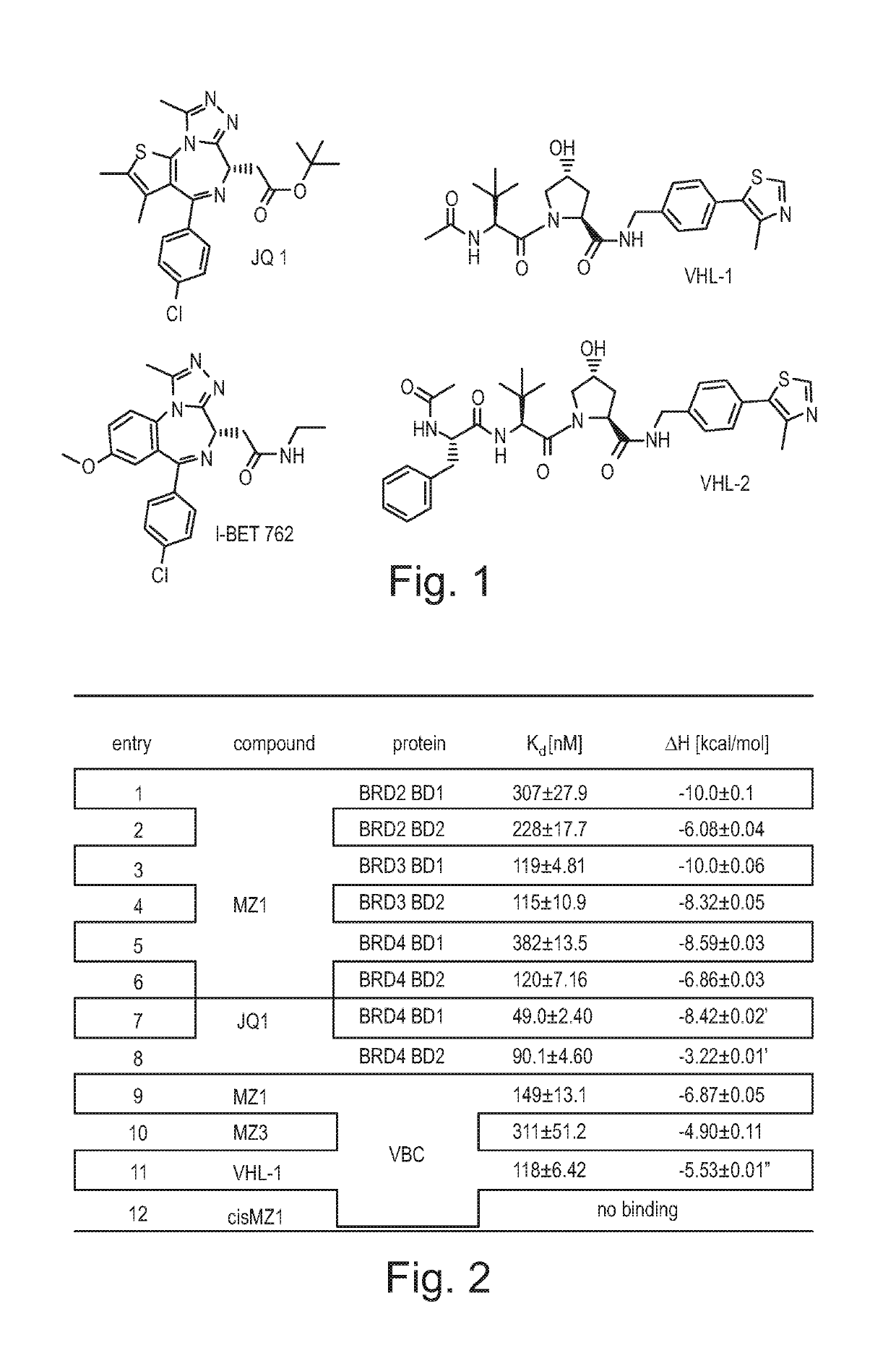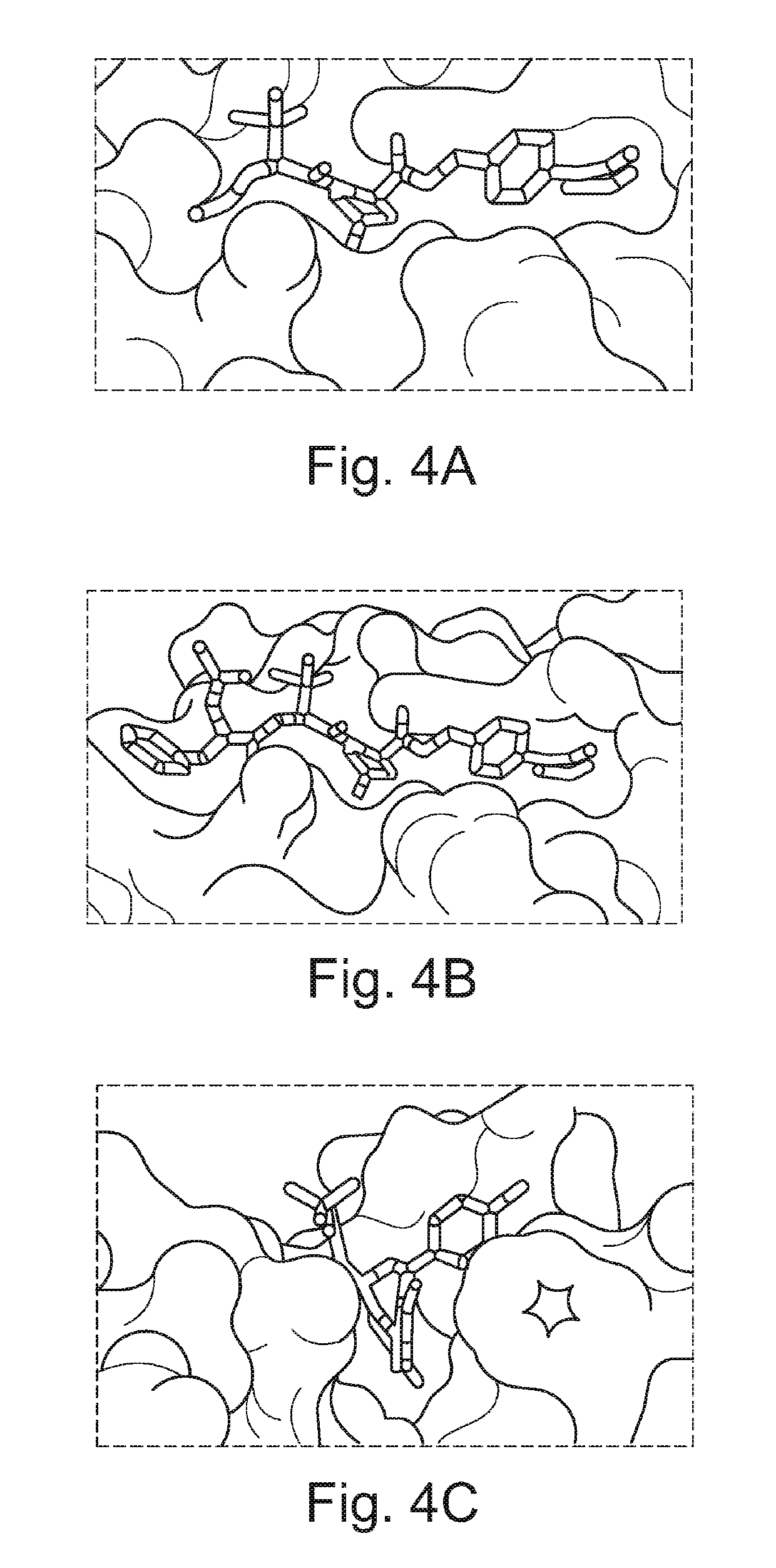Fluorohydroxyproline derivatives useful in the preparation of proteolysis targeted chimeras
a technology of fluorohydroxyproline and chimeras, which is applied in the direction of drug compositions, immunological disorders, peptides, etc., can solve the problems of limiting the scope of chemical probes for validating the roles of individual bet targets in physiology and disease, limiting the scope of the potential utility of current inhibitors as probes, and requiring systemic target engagemen
- Summary
- Abstract
- Description
- Claims
- Application Information
AI Technical Summary
Benefits of technology
Problems solved by technology
Method used
Image
Examples
example compound 18d
tert-butyl)-17-((S)-4-(4-chlorophenyl)-2,3,9-trimethyl-6H-thieno[3,2-f][1,2,4]triazolo[4,3-a][1,4]diazepin-6-yl)-4,16-dioxo-6,9,12-trioxa-3,15-diazaheptadecanoyl)-3-fluoro-4-hydroxy-N-(4-(4-methylthiazol-5-yl)benzyl)pyrrolidine-2-carboxamide
[0398]
[0399]To a solution of preparative compound 16d (7.0 mg, 0.0105 mmol) in methanol (2.0 mL), a catalytic amount of Pd / C (10% dry) was added. The mixture was stirred under hydrogen atmosphere for one hour. HPLC analysis showed complete conversion of the starting material and formation of the desired intermediate amine 17d ((METHOD 2, rt=2.674 min, m / z=638.3, [M+H]+). The mixture was filtered through a syringe filter and the solvent was removed. The crude amine intermediate was then dissolved in DMF (0.5 mL), and added to a solution of JQ1-COOH (4.2 mg, 0.0105 mmol), HATU (4.0 mg, 0.0105 mmol), HOAT (1.5 mg, 0.0105 mmol) and DIEPA (5.4 μL, 0.0315 mmol) in DMF (0.05 mL). The resultant mixture was stirred at room temperature for 3 hr. HPLC analy...
example compound 18b
(tert-butyl)-17-((S)-4-(4-chlorophenyl)-2,3,9-trimethyl-6H-thieno[3,2-f][1,2,4]triazolo[4,3-a][1,4]diazepin-6-yl)-4,16-dioxo-6,9,12-trioxa-3,15-diazaheptadecanoyl)-3-fluoro-4-hydroxy-N-(4-(4-methylthiazol-5-yl)benzyl)pyrrolidine-2-carboxamide
[0401]
[0402]Prepared as described for preparative compound 18d, 72% yield, white solid. HPLC analysis (METHOD 2 rt=3.554 min, m / z=1020.3, [M+H]+)
[0403]1H NMR (400 MHz, MeOD) δ: 8.88 (s, 31367398H), 7.48-7.39 (m, 9H), 5.06-4.90 (m, 1H), 4.71-4.68 (m, 1H), 4.66-4.48 (m, 4H), 4.36 (d, J=16.1 Hz, 1H), 4.10-4.05 (m, 3H), 3.77-3.66 (m, 10H), 3.61 (t, J=5.8 Hz, 2H), 3.49-3.43 (m, 3H), 2.70 (s, 3H), 2.48 (s, 3H), 2.46 (s, 3H), 1.71 (s, 3H), 1.06 (s, 9H). 19F-NMR δ: −200.23.
example compound 18e
(4-((2S,4R)-1-acetyl-4-(4-chlorobenzyl)-2-methyl-1,2,3,4-tetrahydroquinolin-6-yl)phenyl)-12-(tert-buytl)-1,10-dioxo-5,8-dioxa-2,11-diazatridecan-13-oyl)-3-fluoro-4-hydroxy-N-(4-(4-methylthiazol-5-yl)benzyl)pyrrolidine-2-carboxamide
[0404]
[0405]Example compound 18e, was obtained in accordance with the methodology as described for preparative compound 18d, and starting from preparative compound 16e. The product was obtained in 75% yield as a white solid. HPLC analysis (METHOD 2) rt=3.662 min, m / z=883.4, [M-para-chloroaniline]+.
[0406]1H NMR (400 MHz, MeOD) δ: 8.87 (s, 1H), 8.60 (t, J=5.7 Hz, 1H), 7.90-7.75 (m, 3H), 7.64-7.56 (m, 4H), 7.44-7.36 (m, 5H), 7.12-7.09 (m, 2H), 6.73-6.68 (m, 2H), 5.15-5.00 (m, 1H), 4.84-4.75 (m, 2H), 4.46-4.41 (m, 3H), 4.26 (dd, J=4.8, 12.6 Hz, 1H), 4.10-3.94 (m, 4H), 3.76-3.60 (m, 8H), 2.74-2.66 (m, 1H), 2.44 (s, 3H), 2.25 (s, 3H), 1.37-1.29 (m, 1H), 1.19 (d, J=6.5 Hz, 3H), 1.05 (s, 9H). 19F-NMR δ: −192.18
PUM
| Property | Measurement | Unit |
|---|---|---|
| Electric charge | aaaaa | aaaaa |
| Structure | aaaaa | aaaaa |
| Protein activity | aaaaa | aaaaa |
Abstract
Description
Claims
Application Information
 Login to View More
Login to View More - R&D
- Intellectual Property
- Life Sciences
- Materials
- Tech Scout
- Unparalleled Data Quality
- Higher Quality Content
- 60% Fewer Hallucinations
Browse by: Latest US Patents, China's latest patents, Technical Efficacy Thesaurus, Application Domain, Technology Topic, Popular Technical Reports.
© 2025 PatSnap. All rights reserved.Legal|Privacy policy|Modern Slavery Act Transparency Statement|Sitemap|About US| Contact US: help@patsnap.com



